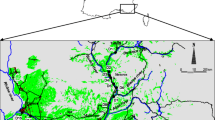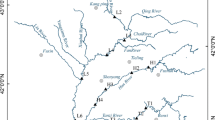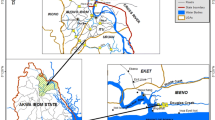Abstract
This study was carried out to estimate the potential toxicity of 8 Polycyclic Aromatic Hydrocarbons (PAHs) and 5 organochlorine pesticides (OCPs) in sediments in the Ebro River Basin (20 sampling points) according to different methodologies. Detection limit (DL) concentrations were used for compounds reported below the DL (worst-case scenario). The majority of PAH concentrations were found to be below their method detection limit. DL concentrations for OCPs were above the threshold values set by one guideline. In such cases, no toxicity assessment was carried out. It should be noted that no sediment is expected to cause adverse effects on the benthic species living in these sediments according to the methodologies applied.
Similar content being viewed by others
Explore related subjects
Discover the latest articles, news and stories from top researchers in related subjects.Avoid common mistakes on your manuscript.
Freshwater sediments are an important source of pollution due to its capability of trapping hazardous and persistent substances such as heavy metals, organic compounds, Polycyclic Aromatic Hydrocarbons (PAHs) and organochlorine pesticides (OCPs) among others (McGrath et al. 2002; U.S.EPA. 2003a, b, c; Zhang et al. 2004; Wang et al. 2008; Hung et al. 2010). Sediment Quality Guidelines (SQGs) provide concentrations that protect organisms from adverse effects that these substances may cause on them (Di Toro et al. 2000; Di Toro and Mcgrath 2000; MacDonald et al. 2000; Wong et al. 2000; U.S.EPA. 2003a, b, c; Vidal and Bay 2005).
The approaches used to develop SQGs mainly include both theoretical and empirical models. Empirical models are based on empirical observations of associations between chemical concentrations in whole sediments and measures of biological effects. Thus, total concentrations are linked empirically to an adverse effect in sediment-dwelling organisms. Consensus-based Threshold Effect Concentration (TEC) and Probable Effect Concentration (PEC) are derived from empirical measures (MacDonald et al. 2000). These guidelines have been successfully applied by Tang et al. (2007) and Hu et al. (2010) to evaluate the occurrence of DDT in China.
On the other hand, theoretical models are represented by the Equilibrium partitioning (EqP) approach. EPA′s Equilibrium Sediment Benchmarks for PAHs mixtures are based on the Equilibrium partitioning (EpP) approach. This approach determines bioavailable concentrations rather than total concentrations in order to predict toxicity in the sediments. These guidelines expressed on an organic carbon-based basis have been used to assess the bioavailability of these hazardous substances in sediments in several studies (McGrath et al. 2002; Martinez-Llado et al. 2007; Ololade 2010; Hung et al. 2010). Finally, EPA′s ESBs guidelines for eldrin and dieldrin are also based on the EqP approach. These two guidelines are intended to provide a concentration in sediment based on both the chemical’s organic carbon–water partition coefficient (KOC) and the Final Chronic Value (FCV) that provides protection to benthic organisms in freshwater (U.S.EPA. 2003b, c).
The Ebro Hydrographical Confederation (CHE), which is the organization in charge of the management of the Ebro River Basin, has been analyzing the concentrations of PAHs and OCPs in sediments from the Ebro River Basin since 1992. Although some studies related to these sediments such as the determination of PAH and OCP concentrations in sediment and fish (Lacorte et al. 2006) or multivariate analysis (Navarro-Ortega et al. 2010) have been carried out, this is the first study that compares and analyzes the main existing SQGs in order to predict the toxicity of PAHs and OCPs in those sediments. As Directive 2008/105/CE does not include any threshold value not to be exceeded, this work aims to fulfill this lack of regulation. As a consequence, this study is expected to give a further step to the methodology currently being used at the Ebro Hydrographical Confederation and provide more reliable results in order to evaluate the quality of sediments from the Ebro River Basin.
Therefore, the aim of this study was to assess the potential toxicity of hazardous substances such as PAHs and OCPs in sediments from the Ebro River Basin (20 sampling points). This assess was conducted according to different guidelines, both theoretical and empirical (consensus-based TEC and PEC, EPA′s Equilibrium Sediment Benchmarks for PAHs mixtures and EPA′s Equilibrium Sediment Benchmarks for endrin and dieldrin). This work also aimed to evaluate which of the methodologies used is best to predict the potential toxicity of the PAHs and OCPs considered in this study.
Materials and Methods
PAH and OCP concentrations were determined in the CHE laboratories according to standard methods. All data related with PAH and OCP concentrations were obtained from www.chebro.es. Organic carbon analyses were performed by wet oxidation (Walkley-Black titration method). The carbon present in the sediment was oxidized with potassium dichromate (a known excess) in concentrated sulfuric acid in the presence of silver sulfate. Ferrous ammonium sulfate was used to titrate this dichromate excess (Hernandez et al. 2008). Sampling point locations are showed in Table 1. A map of the sampling points is represented in Fig. 1.
Consensus-based guidelines provide each substance with two concentrations: TEC below which, no harmful effects on sediment-dwelling organisms are expected to occur and PEC above which, harmful effects on sediment-dwelling organisms are expected to occur frequently (MacDonald et al. 2000). The numerical values of these two guidelines expressed in ug/kg dw (dry weight) are included in Table 2.
EPA′s Equilibrium Sediment Benchmarks for PAHs mixtures (see Table 2) are calculated as the sum of all concentrations of each PAH (dry weight concentrations for each PAH must be converted to μg PAH/g organic carbon by dividing by the organic carbon fraction (fOC) where fOC = %TOC/100) divided by their FCV concentration for each specific PAH in sediment (COC,PAHi,FCVi, μg/g organic carbon). This sum is named as the Equilibrium Partitioning Sediment Benchmark Toxic Unit (∑ESBTUFCV). Values of ∑ESBTUFCV < 1 would indicate that sediments are acceptable for the protection of benthic organisms. This guideline requires the determination of 33 PAHs concentrations but it can be used in case just 13 PAHs concentrations are measured by multiplying the calculated ∑ESBTUFCV,8 (number 8 stands for 8 measured PAHs) by a factor of 11.5 (U.S.EPA. 2003a). As this study only took into account 8 out of those 13 PAHs, results obtained should be interpreted with caution.
EPA′s Equilibrium Sediment Benchmarks (endrin and dieldrin) are derived from the FCV that already exists in water-only exposures and the chemical’s organic carbon–water partition coefficient (KOC). They represent the concentration in sediment (normalized to organic carbon) below which, adverse effects are not expected to occur (U.S.EPA. 2003b, c). ESBs for freshwater sediments according to this guideline are included in Table 2.
Concentrations were calculated assuming detection limit (DL) concentrations where real concentrations were under DL concentrations (worst-case scenario). Therefore, if all guidelines criteria were met in this case, we would be able to certify that real concentrations (obviously below DL) would, with no doubt, meet these criteria. However, method detection limit values for OCPs were above the threshold values set by consensus-based TEC guideline. Values reported in those cases are generally not used to carry out a bioavailability assessment because of the uncertainties that appear when DL concentrations are higher than the guideline itself (Long et al. 2006). Therefore, TEC guideline was not applied in such cases.
Results and Discussion
Table 3 outlines the results obtained in all sediment samples assuming DL concentrations where real concentrations were under DL as discussed previously. It also includes the results obtained in the determination of organic carbon (expressed as TOC%) by Walkley-Black titration method. TOC% presented the higher value in sediment SP-8 (7.33%) and the lower value in sediment SP-11 (0.81%). This relatively high organic carbon content in sediment SP-8 could be explained by means of the human activity related to the city of Vitoria, located next to the sampling point. Benzo(b)fluoranthene in sediment SP-6 (122 μg/kg dw) and fluoranthene in sediment SP-6 (131 μg/kg dw) represented the higher PAH concentrations found in all samples. Nevertheless, all sampling points showed concentrations below the threshold concentration set by TEC guideline for both individual and total PAHs.
As can be noticed from Table 4, total PAHs ranges found in our study assuming DL concentrations for values reported under DL concentrations (80–516 μg/kg dw) were in line with total PAHs ranges found on different studies all over the world which were found to range from 127 μg/kg dw (Tonghui River of Beijing, China) up to 1,590 μg/kg dw (Danshui River in Taiwan).
No sediment presented OCP concentrations above the method detection limit with the exception of DDT in sediments SP-5.1 and SP-9. These DDT values were higher than those reported by different studies around the world (Table 4). No toxicity assessment was carried out when DT concentrations for OCPs were above the threshold values set by TEC guideline, as discussed previously.
Total DDT concentration in sediments SP-5.1 and SP-9 were found to range between the concentrations set by TEC and PEC guidelines. Therefore, adverse effects on the benthic fauna might or might not occur, indicating a clear uncertainty in order to predict toxicity on the sediments studied. Although the use of DDT for agricultural purposes was banned several years ago, these remaining concentrations found in sediments from the adjacent areas highlight the low degradability of DDT. The presence of DDT in sediment SP-5.1 (Cinca River at Monzon) might be due to the presence of a pesticide manufacturer that operated in the area for several years (the company ceased trading in 2008). Moreover, in comparison with values reported by Lacorte et al. (2006) on a previous study, total DDT concentration has decreased 4.1% in sediment SP-9 from 2002 to 2009.
Data shown in Table 3 are used as well to determine whether or not PEC criteria are met in the sediments studies. In this case, all sediments present concentrations below PEC in all substances according to the values outlined in Table 2. As a consequence, no sediment is expected to cause any adverse effect in the benthic organisms.
Results obtained from EPA′s ESBs for endrin and dieldrin are shown in Fig. 2. As endrin and dieldrin concentrations were assumed as their DL concentration (10 μg/kg dw), their values are the same for each sediment sample. Organic carbon-based concentrations found on sediments SP-1 and SP-2 were the higher ones (1.000 μg/gOC and 1.075 μg/gOC, respectively). Nevertheless, all 11 sediments studied had very low endrin and dieldrin carbon-based concentrations with regard to the threshold values given by the methodology. It is noticeable that threshold values of 5.4 and 12 μg/gOC are never exceeded. Therefore, no adverse effect is expected to occur due to the presence of both endrin and dieldrin in the benthic organisms that inhabit in the sediments studied.
Finally, data obtained for EPA′s ESB for PAHs mixtures are outlined in Table 3. It can be seen that TU are below 1 in all sediments both by ESBTUFCV,8 and ESBTUFCV,8 (×11.5) . The higher ESBTUFCV,8 values were found in sediments SP-5.1 and SP-11 (0.334 and 0.299 TU). This low TU values obtained suggest that all sediments are acceptable for the protection of benthic organisms.
Conclusions
For PAH methodologies, these conclusions can be extracted:
-
Both consensus-based and EPA′s ESB for PAHs mixtures guidelines lead to comparable results in the sediments studied.
-
Due to the low PAH concentrations found in all sediments, theoretical and empirical models are suitable for determining the potential toxicity of PAHs in the sediments studied.
For OCP methodologies, this conclusion can be extracted:
-
Consensus-based PEC seems to be a reliable guideline in order to protect benthic organisms from any harmful effect. On the other hand, EPA′s ESBs guidelines for eldrin and eldrin take into account organic carbon present in the sediment and thus, reliably predict eldrin and dieldrin bioavailability in this study.
Method detection limit concentrations for OCPs should be improved in order to be able to apply TEC guideline to assess OCP toxicity in sediments from the Ebro River Basin. Besides, it should be pointed out that no sediment is expected to cause adverse effects on the benthic species living in these sediments according to the methodologies applied. As Directive 2008/105/CE does not include any threshold value or bioavailable concentrations neither for PAHs nor OCPs, and accounts only for the no variation of their concentrations along time, this study has been proved to better understand and to estimate the quality of the sediments of the Ebro River Basin.
References
Di Toro DM, Mcgrath JA (2000) Technical basis for narcotic chemicals and polycyclic aromatic hydrocarbon criteria. II. Mixtures and sediments. Environ Toxicol Chem 19(8):1971–1982
Di Toro DM, Mcgrath JA, Hansen DJ (2000) Technical basis for narcotic chemicals and polycyclic aromatic hydrocarbon criteria. I. Water and tissue. Environ Toxicol Chem 19(8):1951–1970
Hernandez S, Franco C, Herrera C (2008) Carbono orgánico y materia orgánica en sedimentos superficiales de la Bahía Concepción. Ciencia…Ahora 21 (In Spanish)
Hu W, Wang T, Khim J, Luo W, Jiao W, Lu Y, Naile J, Chen C, Zhang X, Giesy J (2010) HCH and DDT in sediments from marine and adjacent riverine areas of North Bohai Sea, China. Arch Environ Contam Toxicol 59:71–79
Hung CC, Gong GC, Ko FC, Chen HY, Hsu ML, Wu JM, Peng SC, Nan FH, Yeager KM, Santschi PH (2010) Relationships between persistent organic pollutants and carbonaceous materials in aquatic sediments of Taiwan. Mar Pollut Bull 60(7):1010–1017
Lacorte S, Raldua D, Martinez E, Navarro A, Diez S, Bayona JM, Barcelo D (2006) Pilot survey of a broad range of priority pollutants in sediment and fish from the Ebro river basin (NE Spain). Environ Pollut 140(3):471–482
Long ER, Ingersoll CG, MacDonald DD (2006) Calculation and uses of mean sediment quality guideline quotients: a critical review. Environ Sci Technol 40:1726–1736
MacDonald DD, Ingersoll CG, Berger TA (2000) Development and evaluation of consensus-based sediment quality guidelines for freshwater ecosystems. Arch Environ Contam Toxicol 39:20–31
Martinez-Llado X, Gibert O, Marti V, Diez S, Romo J, Bayona JM, de Pablo J (2007) Distribution of polycyclic aromatic hydrocarbons (PAHs) and tributyltin (TBT) in Barcelona harbour sediments and their impact on benthic communities. Environ Pollut 149(1):104–113
McGrath JA, Paquin PR, Di Toro D (2002) Use of the SEM and AVS approach in predicting metal toxicity in sediments. Fact sheet on environmental risk assessment. Published by the International Council on Mining and Metals (ICMM). No. 10. London, UK
Navarro-Ortega A, Tauler R, Lacorte S, Barcelo D (2010) Occurrence and transport of PAHs, pesticides and alkylphenols in sediment samples along the Ebro River Basin. J Hydrol 383(1–2):5–17
Ololade IA (2010) Prediction of polycyclic aromatic hydrocarbons toxicity using equilibrium partitioning approach and narcosis model. Bull Environ Contam Toxicol 85:238–242
Persaud DR, Jaagumagi R, Hayton A (1993) Guidelines for the protection and management of aquatic sediments in Ontario. Standards Development Branch. Ontario Ministry of Environment and Energy. Toronto, Canada
Tang ZW, Yang ZF, Shen ZY, Niu JF, Liao RF (2007) Distribution and sources of organochlorine pesticides in sediments from typical catchment of the Yangtze River, China. Arch Environ Contam Toxicol 53:303–312
U.S.EPA (2003a) Procedures for the derivation of equilibrium partitioning sediment benchmarks (ESBs) for the protection of benthic organisms: PAH mixtures. EPA-600-R-02 013. Office of Research and Development. Washington, DC 20460
U.S.EPA (2003b) Procedures for the derivation of equilibrium partitioning sediment benchmarks (ESBs) for the protection of benthic organisms: Endrin. EPA-600-R-02-009. Office of Research and Development. Washington, DC 20460
U.S.EPA (2003c) Procedures for the derivation of equilibrium partitioning sediment benchmarks (ESBs) for the protection of benthic organisms: Dieldrin. EPA-600-R-02-010. Office of Research and Development. Washington, DC 20460
Vidal DE, Bay SM (2005) Comparison of sediment quality guideline performance for predicting sediment toxicity in southern California. Environ Toxicol Chem 24(12):3173–3182
Wang JZ, Nie YF, Luo XL, Zeng EY (2008) Occurrence and phase distribution of polycyclic aromatic hydrocarbons in riverine runoff of the Pearl River Delta, China. In: 15th international conference on marine pollution and ecotoxicology. Mar Pollut Bull 57(6–12):767–774
Wong CS, Capel PD, Nowell LH (2000) Organochlorine pesticides and PCBs in stream sediment and aquatic biota – initial results from the National Water-Quality Assessment Program, 1992–1995. US Geological Survey Water-Resources Investigations Report 00-4053, Sacramento, California
Zhang Z, Huang J, Yu G, Hong H (2004) Occurrence of PAHs, PCBs and organochlorine pesticides in the Tonghui River of Beijing, China. Environ Pollut 130:249–261
Acknowledgments
The authors of this study wish to acknowledge the partnership project between the University of Zaragoza and the Ebro Hydrographical Confederation and MICINN-FEDER funding through CTM2008-01876/TECNO project.
Author information
Authors and Affiliations
Corresponding author
Rights and permissions
About this article
Cite this article
Veses, O., Mosteo, R., Ormad, M.P. et al. Potential Toxicity of Polycyclic Aromatic Hydrocarbons and Organochlorine Pesticides in Sediments from the Ebro River Basin in Spain. Bull Environ Contam Toxicol 88, 644–650 (2012). https://doi.org/10.1007/s00128-011-0519-1
Received:
Accepted:
Published:
Issue Date:
DOI: https://doi.org/10.1007/s00128-011-0519-1






